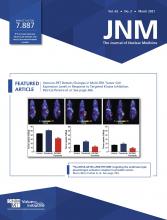Discussions with leaders: Johannes Czernin, MD, talks with Hong Wu, MD, PhD, professor and dean of the School of Life Sciences and a senior investigator of the Peking–Tsinghua Center for Life Sciences at Peking University.
Page 293
FAPI review: Hicks and colleagues look at the development of and preliminary clinical data on various fibroblast-activation protein–specific small-molecule inhibitor tracers in oncologic and potential nononcologic applications.
Page 296
Phantom preparation: Lodge emphasizes the importance of reliable phantom preparation in PET methodology research, performance assessment, and routine quality assurance and describes an existing dilution technique that can simplify the process.
Page 303
Nuclear medicine in hyperthyroidism: Mariani and colleagues provide the first in a series on the role of nuclear medicine in clinical management of benign thyroid disorders, which constitute most diseases affecting the thyroid gland.
Page 304
Melanoma imaging and therapy: Miao and Quinn focus on preclinical and clinical advances in melanocortin-1 receptor– and very late antigen-4–targeted radiolabeled peptides and peptide-conjugated C′ dots for melanoma imaging and therapy.
Page 313
18F-FDOPA and MRI in glioma: Tatekawa and colleagues identify correlations between PET 18F-FDOPA uptake and physiologic MRI, including relative cerebral blood volume and apparent diffusion coefficient, in gliomas with different molecular subtypes.
Page 319
18F-FES vs. 18F-FDG in ILC: Ulaner and colleagues detail head-to-head comparison of 18F-FDG and 18F-FES in PET/CT assessment of patients with metastatic invasive lobular carcinoma.
Page 326
MTV segmentation in DLBCL: Barrington and colleagues evaluate the optimal automated metabolic tumor volume workflow in diffuse large B-cell lymphoma, assess factors influencing the success of segmentation, and report on the discriminatory power of segmentation methods.
Page 332
PET criteria in HL relapse: Kluge and colleagues compare interim PET responses to second- and first-line treatment in classic Hodgkin lymphoma as part of development of response criteria for relapsed or progressive disease.
Page 338
Fluorescence-guided surgery in sarcomas: Steinkamp and colleagues determine the feasibility, safety, and optimal dose of bevacizumab-800CW for fluorescence-guided surgery in soft-tissue sarcoma, including in vivo and ex vivo tumor detection.
Page 342
PET/MRI in isolated limb perfusion: Chodyla and colleagues evaluate and compare the clinical utility of simultaneously obtained quantitative 18F-FDG PET and diffusion-weighted MRI datasets for predicting histopathologic response of soft-tissue sarcoma to neoadjuvant isolated limb perfusion.
Page 348
uPAR PET/MRI in prostate cancer: Fosbøl and colleagues assess correlations between uptake of the PET ligand 68Ga-NOTA-AE105, targeting the urokinase-type plasminogen activator receptor, and Gleason scores in patients undergoing prostate biopsy.
Page 354
99mTc-PHC-102 in renal cell carcinoma: Kulterer and colleagues describe the targeting performance of this radiolabeled derivative of acetazolamide in SPECT imaging in patients with renal cell carcinoma, including safety and tolerability data.
Page 360
Immuno-PET and response to therapy: Pereira and colleagues investigate the utility of receptor tyrosine kinase–targeted immuno-PET to annotate changes in multi-RTK tumor cell expression levels in response to targeted therapies.
Page 366
Imaging lymphoma with F(ab′)2 fragments: Kang and colleagues report on development of 64Cu-labeled F(ab′)2 fragments of obinutuzumab for imaging CD20 in lymphoma xenograft tumor models.
Page 372
DNA damage in 177Lu therapy: Ritt and colleagues compare excess radiation-induced foci and other factors side by side in recipients of 177Lu-DOTATOC or 177Lu-prostate-specific membrane antigen-617 radioligands.
Page 379
177Lu-DOTA-EB-TATE therapy in NETs: Liu and colleagues report on the safety and efficacy of multiple cycles of 177Lu-DOTA-Evans blue-TATE peptide receptor radionuclide therapy (PRRT) at escalating doses in neuroendocrine tumors.
Page 386
Preclinical 177Lu-DOTA-JR11 assessment: Albrecht and colleagues evaluate peptide-receptor radionuclide therapy with somatostatin receptor agonist 177Lu-DOTATOC and antagonist 177Lu-DOTA-JR11 with PET/MRI and SPECT/CT in an orthotopic murine pancreatic neuroendocrine neoplasm model expressing human SSTR2.
Page 393
PE imaging in asthma: Lazarus and colleagues look at the diagnostic performance of pulmonary embolism imaging with ventilation–perfusion scanning or CT pulmonary angiography in patients with a history of asthma.
Page 399
Early lung perfusion changes in HIV: Kohli and colleagues investigate pulmonary perfusion and ventilation using 13NN-saline PET/CT imaging in smokers and nonsmokers living with HIV.
Page 405
Nondisplaceable binding in TSPO PET: Laurell and colleagues use a recently developed method for simultaneous estimation of nondisplaceable-binding distribution volume to disentangle its contributions from ligand-specific distribution volume in 11C-PBR28 PET studies.
Page 412
11C-UCB-J SUVR in humans: Naganawa and colleagues detail simplification of the protocol for this PET tracer through comparison of SUV ratios with model-based nondisplaceable-binding potential to derive optimal imaging time windows in healthy and neuropsychiatric subjects.
Page 418
Global radiopharmaceutical availability: Cutler and colleagues from the Nuclear Medicine Global Initiative report on the results of a survey designed to explore issues affecting international access and availability of radiopharmaceuticals.
Page 422
- © 2021 by the Society of Nuclear Medicine and Molecular Imaging.







